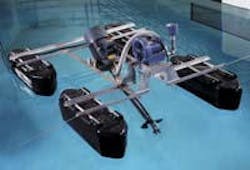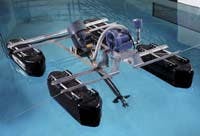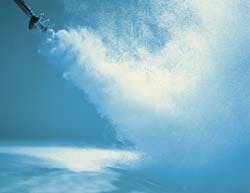Efficient Aerator/Mixer Nets Energy Savings
A new aerator/mixer system is saving municipalities money in electrical costs. With more efficient oxygen transfer and greater mixing capabilities, the system consumes less energy, which has resulted in significant operational savings to municipalities. The system also provides Biological Nutrient Removal (BNR) in one compact unit, resulting in more savings. In the nitrification mode, aeration and mixing take place simultaneously. When denitrifying, the unit operates in the mixer-mode only, providing operational versatility.
The system, the Triton Aire-02 aerator/mixer from Aeration Industries, has the ability to disperse oxygen throughout a wastewater treatment basin, which is the key to its oxygen transfer and performance effectiveness. Factors that effect oxygen transfer and wastewater treatment performance efficiency include bubble size, hang time and complete mixing of a basin to prevent dead spots and short circuiting.
The Triton process aerator/mixer is a motor-driven, air-assist, propeller-type floating surface aerator that is equipped with an on-board regenerative blower. The aerator/mixer injects air into the water through a hollow shaft. A specially designed PowerShear™ Prop then breaks up the air into fine bubbles, as defined by the U.S. Environmental Protection Agency. The plume of bubbles is driven outward by a PowerMix™ prop, extending contact time and reach of the bubbles for maximum oxygen dispersion or "hang time" effectiveness.
The units are powered at 900 rpm versus 1800/3600 rpm of other surface aerators. They are available in multiple horsepower sizes and are suitable for municipal and industrial applications using activated sludge, oxidation ovals, aerated lagoons, sequencing batch reactors (SBRs), and/or aerobic sludge holding lagoon/tank systems.
Oxygen Transfer EfficiencyNumerous factors affect oxygen transfer calculations, including alpha factor, beta factor, wastewater temperature, and site elevation. Alpha and beta are used as correctional factors in calculating oxygen requirements. They account for the difference between process water characteristics and clean water. Each wastewater has a unique alpha factor.Bubble size is one of the components that determines alpha factor along with surfactants, turbulence, power input per unit volume (hp/MG), tank geometry and degree of treatment. Here we will concentrate on the significance of bubble size.
The Triton process aerator/mixer breaks the bubbles into a 2 mm bubble size, which is defined by EPA as "fine bubble." Breaking up a one inch diameter bubble into a fine bubble increases the total surface area from 3.14 square inches to more than 39 square inches. The fine bubbles also have a longer hang time. Increasing surface area and creating longer hang times mean more oxygen transfer.
The technology also produces a horizontal and circular flow pattern, providing whole basin circulation. Its dual props create a high velocity horizontal stream of oxygen that sweeps solids along with it, keeping them in suspension for more efficient biological treatment. This dispersion of oxygen throughout the basin results in more efficient wastewater treatment and higher removal rates of Biological Oxygen Demand (BOD) and suspended solids.
The aerator/mixers are typically placed to create a "flow linkage" between units. This keeps solids in suspension to be treated by the uniform DO (dissolved oxygen) levels. The ability to maintain desired velocities and oxygen dispersion of any size basin through horsepower and linkage ensures energy consumption for aeration and mixing only. It also helps prevents treatment problems such as short-circuiting and dead zones.
The aerators can be turned on and off to match the demand of the system (turn-down capability) to meet fluctuating hydraulic flows or loadings in the wastewater, resulting in additional energy savings.
Electrical SavingsWith the Triton system's high oxygen dispersion/mixing rates and more effective treatment removal rates, fewer units are required to meet a facility's standards. Electrical savings for operational costs can be calculated by a formula where:kW x $/kW/hr x hr of operation = operating costs.
For example, a recent application installed a 100 hp Triton System in place of 225 hp of another aeration technology. Thus, a 125 hp savings in operational equipment means:
The result was a $49,012 savings in one year, or a $245,061 savings over 5 years.
Case StudiesA municipality need not replace an entire system to realize significant electrical savings. The following examples demonstrate the impact of upgrading aging equipment in existing systems with Triton aerator/mixers.The Town of Buckeye, AZ, recently replaced a 40 hp brush rotor with two 10 hp Triton aerator/mixers in its activated sludge oxidation oval system. Buckeye reduced its rotor power consumption by half or by 20 hp. Using the above electrical formula, the town will realize an energy savings of $10,455 for the year or $52,275 over five years:
20 hp (.746) x (0.08) {cost of electricity in AZ} x 24 hrs/day x 365 days/yr = $10,455
The largest municipal lagoon system in the country upgraded its system with several Triton aerator/mixers. The City of Logan, UT, had operated a full Aire-O2 aspirator aeration system for more than a decade. Population growth called for the additional equipment. The Triton aerator/mixers do not run continuously, which is a feature appreciated by Logan. A city official estimated energy savings of approximately $20,000 per year since installation of the aerator/mixers in its lagoons. WW/



